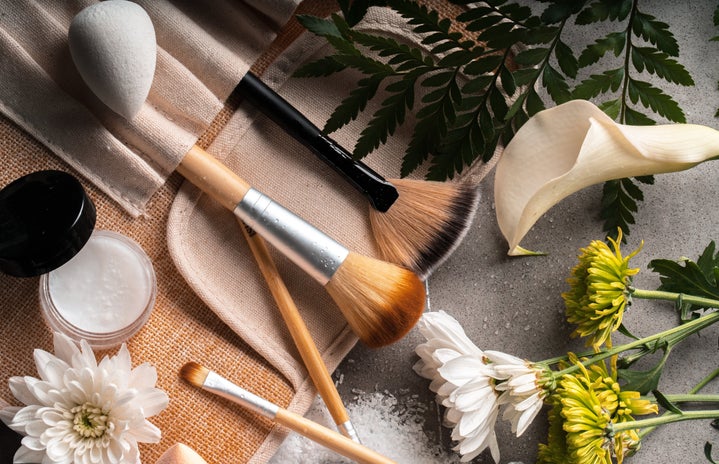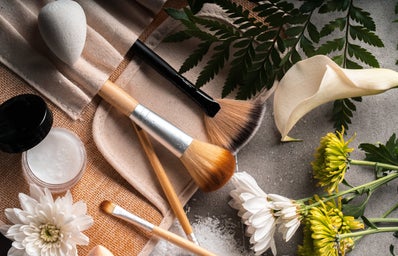Paraben-free. Organic. No synthetic fragrances. Nontoxic.
All of this jargon is thrown at us on beauty product labels and advertisements to think we chose the most natural option. But are we? Are these terms just buzzwords to make us pick up that sunscreen or shampoo bottle over others? What exactly does each of these phrases mean?
The clean beauty industry is a growing market, estimated to reach $22 billion globally by 2024. There are various driving forces for this increasing demand for cleaner beauty products. Heather Ibberson, a retail analyst for EDITED, explained to Forbes that “the declaration of a climate emergency has increased consumer awareness and grown demand for ethical and environmentally-friendly products.” She additionally cited “wellness and self-care trends” as part of this growing pattern.
The shift to clean beauty is a necessary one. The benefits of opting for eco-friendly and all-natural products are overwhelming as the environmental destruction and personal health hazards caused by the beauty industry are intricately linked. Many ingredients commonly used in beauty products that cause harm to our health often have detrimental effects on the environment as well.
Phthalates were ubiquitous—nail polish, hair spray, body lotions, deodorants, shampoos, fragrances, and so on. That is until they were found to have been linked to asthma, breast cancer, obesity, ADHD, neurodevelopmental issues, male fertility issues, and other concerning medical ailments. Phlatates are defined by the CDC as “a group of chemicals used to make plastics more durable” and are riddled not only in our personal care products, but in lubricating oils, plastic packaging, vinyl flooring, and so many more products that make you really think “How could something be in both my hand lotion and garden hose?” Triclosan and triclocarban are antimicrobial agents common in deodorants, cleansers, and color cosmetics that disrupt endocrine function. When such chemicals as phthalates, triclosan, and triclocarban are used by humans through cosmetic use, they are exposed to the environment through aerosols spraying into the air or household water waste. The toxicity of these chemicals is exposed and poses a threat to other living organisms, such as aquatic ecosystems.
And yet, these chemicals are barely regulated in cosmetics by the FDA. The list of ingredients that imposes harm to ecosystems and human health and functions is egregiously long. While the European Union has banned over 1,000 of such chemicals previously found in cosmetic products, the United States has banned or restricted a whopping 30 ingredients.
So how can we be sure we are in fact getting truly clean products and not just getting sucked into a whirlpool of organic-blather and corporate greed with an eco-friendly facade?
Here is your cheat sheet for breaking down and navigating the convoluted realm of clean beauty:
Green Glossary: Decode the label by formally understanding these inescapable terms.
Natural is a very vague term and is incredibly manipulative on labels. Board-certified dermatologist Dr. Debra Jaliman warns that a product labeled as “natural” will have “at least some natural ingredients” in the formula, but can “contain up to 30% synthetic ingredients.” Only a product labeled “100% natural” will be free of synthetic ingredients.
Clean does not necessarily have a clear definition to pinpoint as Cosmetic Dermatologist Dr. Michele Green explains there are not any “government agencies that regulate clean skincare like the food industry.” The primary attribute of a “clean” label is that the product does not contain irritating or toxic ingredients, whether natural or synthetic.
Nontoxic means that the product does not contain ingredients that may cause adverse reactions or health effects. It can also mean none of the ingredients used are deemed toxic by any third-party resources such as various environmental organizations or the European Union.
Hypoallergenic simply means that the product is not very likely to cause a reaction for those with sensitive skin.
Parfum/Fragrances can be a variety of any fragrant ingredient, synthetic or natural, as cosmetic companies are not required by the FDA to disclose specific fragrances. These are dangerous as a number of harmful chemicals are often used as a fragrant, yet these chemicals do not have to be specified. One way to know if a product contains synthetic fragrances is that the scent is longer lasting than that of natural fragrances.
Natural Fragrances signify that the fragrant ingredients are derived from raw and natural materials, such as essential oils.
Unscented may not have a scent, but there are often still chemicals to cover up the fragrance.
Fragrance-Free is optimal for those with sensitive skin or allergies as fragrances—especially synthetic ones—can cause reactions. Unlike unscented products, there is absolutely no type of fragrance, even those that mask a scent.
Non-Comedogenic is a word to look out for those with oily or acne-prone skin as it signifies that there are no ingredients proven to clog pores.
Cruelty-Free also comes in the form of the Leaping Bunny logo, issued by Cruelty Free International. This indicates that the product has not been tested on animals.
Vegan differs from “cruelty-free” in that not only has the product not been tested on animals, but it also does not contain any animal products or by-products. But a “vegan” label is not enough. A product is truly vegan if it has been certified, so lookout for a Vegan Awareness Foundation or Vegan Action logo.
USDA/Certified Organic is far more reliable than just an “organic” label because as Dr. Jaliman puts it, “in order for a product to be considered ‘certified organic,’ the item must be 95% or higher free of synthetic additives like pesticides, chemical fertilizers, and dyes.”
Ingredients to avoid:
Although the list of ingredients that should be barred is seemingly endless, there are some to especially try to avoid. The David Suzuki Foundation—a non-profit environmental organization based in Canada—designated the following ingredients as “The Dirty Dozen” as each are both health and environmental hazards.
BHA and BHT Found in lip products and moisturizers
Coal Tar Dyes Found in hair dye
DEA and DEA Compounds Found in soaps, cleansers, shampoos, moisturizers, and sunscreens
Dibutyl Phthalate (DBP) Found in nail polish
Formaldehyde Found in shampoos, lotions, deodorants, and eye makeup products (mascara, eye liner, etc.)
Parabens Found in face makeup products (foundation, BB and CC cream, blush, etc.) shampoos, conditioners, shaving cream, lip products, face cream, sunscreen, and petroleum jelly
Parfum/Fragrance Found in essentially every personal care product
PEGs Found in moisturizers, face creams, cleansers, and face makeup products
Petrolatum Found in petroleum jelly, moisturizers, and hair care products
Siloxanes Found in deodorants, moisturizers, and facial treatments
SLES/Sulfates Found in shampoos, cleansers, and other products that lather
Triclosan Found in cleansers, deodorants, and some pigmented cosmetics
How to find the best clean brands:
Beautycounter is considered a trailblazer in the realm of clean beauty. Since 2013, they have lobbied on the state and federal levels to promote legislation on cosmetic safety, working in tangent with medical and public health policy leaders. In doing so, they advocate for barring harmful chemicals in products and enhancing funding for research for green chemistry. Their motto—“formulate, advocate and educate”—guides the company’s mission of developing cleaner beauty products and setting safer standards for all.
“The Clean Guide” collects and commemorates clean beauty, wellness, home, fashion, and nutrition brands committed to “transparency, quality, and integrity.” Mentioned on the list are Virtue Labs, Briogeo, Playa, Henry Rose, The 7 Virtues, and others. Of course, these are not the only clean beauty brands. Some other acclaimed brands include Ilia, Kosas, Milk Makeup, Versed, Tula, and so on.
For something called clean beauty, it seems to get messy very quickly with all of the bureaucratic tape and triple-meaning words. But it should not be this complicated or stressful. If using cleaner beauty products is important to you, so long as you do a bit of research and listen to your skin and body, you can easily make informed decisions when it comes to your next Sephora spree.


